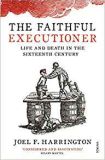The Faithful Executioner: Life and Death in the Sixteenth Century by Joel F Harrington
| The Faithful Executioner: Life and Death in the Sixteenth Century by Joel F Harrington | |
|
| |
| Category: True Crime | |
| Reviewer: John Van der Kiste | |
| Summary: The life and grim career of Franz Schmidt, official executioner of Nuremberg for over forty years in the 16th and 17th centuries, based on his personal journal. This review contains references that some readers may wish to avoid. | |
| Buy? Maybe | Borrow? Yes |
| Pages: 287 | Date: May 2014 |
| Publisher: Vintage | |
| ISBN: 9780099572664 | |
| Video:
| |
Frantz Schmidt, the official executioner and torturer in Nuremberg, the Albert Pierrepoint of his day, entered his terrible profession by accident. In 1553, shortly before he was born, the Margrave of Brandenburg-Kulmbach had three gunsmiths arrested after they were found guilty of plotting to kill him. Invoking a local custom, he called on a random bystander to execute them, and his choice fell on Heinrich Schmidt to carry out the sentence. If he disobeyed, he and the two men standing next to him would also be summarily hanged. Having thus been made to carry out one execution, Schmidt and his family were ostracised by all respectable citizens in their home town of Nuremberg and banned from all public buildings. He therefore had no choice but to take it up as a lifelong career.
If anybody doubted that the medieval age was a savage one and that historical legends have tended to exaggerate the cruelty of everyday life, a mere glance inside this book will indeed remind us that life was every bit as brutal as we thought. Before I go any further, be warned that it is impossible to review this book without conveying some of that brutality herewith, a cruelty that emanated from criminal and agent of punishment alike.
As an adolescent apprentice to his father, Schmidt was required to practise his skills on rotten vegetables, rhubarb stalks and then stray dogs first before being allowed to ‘work’ on human beings. Being an educated man, he kept a personal journal recording all the sentences he carried out throughout his employment, from 1573 at the age of nineteen, until his retirement in 1618. It is on this document that the book is largely based.
It was a dirty job, but somebody had to do it – and had to do it properly. There was more to being the official public executioner of Nuremberg than ‘terminating the earthly existence’ of miscreants. Once appointed, he was also required to undertake the equally unpleasant task of interrogating the guilty people while they were being tortured, and sometimes carry out the punishment of mutilation, by such methods as tearing out parts of their flesh with tongs, or breaking them on the wheel. All this needed to be done with precision, and required familiarity with the proper use of swords, tongs, shackles, rope, hemp bags, hammers, and all manner of wood stakes in order to avoid clumsy maimings or botched dispatchings that might inflame the spectators, bring the forces of law and order in the city into disrepute, and put the executioner himself at risk of being torn apart by an angry crowd. That he came through his career of more than forty years in which he carried out death sentences on 394 men, women and boys, and whipped, tortured or mutilated hundreds more by branding them or lopping off their fingers, ears or tongues, suggests that he acquitted himself efficiently enough. One of those he was called upon to send on his way was his own brother-in-law, a serial housebreaker, burglar and multiple murderer. To do so may not have been as hard as it seems, for it was essential that Schmidt and his family were seen as law-abiding citizens, and to have a criminal connected to them would threaten his livelihood.
From a 21st-century perspective, it sounds well nigh incomprehensible that a public servant could be employed thus. But it was a violent time, when somebody had to administer justice on behalf of the community, to avenge the victims, bring to an end the threat posed by dangerous and often habitual criminals in their midst, and also act as a deterrent to others. Although Schmidt was detested and reviled by his peers, we saw himself as the bulwark and protector of civilised society, as did the authorities of Nuremberg. He regarded himself as a compassionate man – but compassionate towards the victims of crime, rather than those who were responsible for inflicting suffering on others.
In his view, the latter deserved no mercy. Two brothers were brought to justice for murdering two pregnant women, cutting out the babies and bludgeoning them to death. A thief was apprehended for breaking into the house of one of his relations, inflicting 38 wounds on his head with a jagged stone and then stabbing him to death with a shoemaker’s knife. Another man was convicted after he ‘made a child with a poor maid who had no legs’. Such people, he believed, were beyond redemption. A few people were put to death for comparatively trifling crimes, such as a serial thief executed for stealing honey. However, even taking a single item of food from somebody who was living on the edge of destitution was crime enough.
It has to be said, though, that after reading through many pages of what is to some extent little more than a list of crime after crime can become wearing for all but the most dedicated reader. The text from Schmidt’s diary occupies only a small proportion of the book, and much of it reflects the author’s personal thoughts about how he might have felt or behaved about such and such a crime – a tactic which smacks of padding in a work of non-fiction. Moreover, the constant deviation from chronology is a little disconcerting. References are made to episodes from his younger days during the chapters about his later life, which tend to spoil the flow. It is an interesting but somewhat flawed read.
If this book appeals then we can also recommend The Last Witch of Langenburg: Murder in a German Village by Thomas Robisheaux.
Please share on: ![]() Facebook,
Facebook, ![]() Twitter and
Twitter and
![]() Instagram
Instagram
![]() You can read more book reviews or buy The Faithful Executioner: Life and Death in the Sixteenth Century by Joel F Harrington at Amazon.co.uk Amazon currently charges £2.99 for standard delivery for orders under £20, over which delivery is free.
You can read more book reviews or buy The Faithful Executioner: Life and Death in the Sixteenth Century by Joel F Harrington at Amazon.co.uk Amazon currently charges £2.99 for standard delivery for orders under £20, over which delivery is free.
![]() You can read more book reviews or buy The Faithful Executioner: Life and Death in the Sixteenth Century by Joel F Harrington at Amazon.com.
You can read more book reviews or buy The Faithful Executioner: Life and Death in the Sixteenth Century by Joel F Harrington at Amazon.com.
Comments
Like to comment on this review?
Just send us an email and we'll put the best up on the site.


